IOC和Aop使用的擴展,IOCAop使用擴展
下面還有靜態代理和動態代理
1.構造注入
lib包:
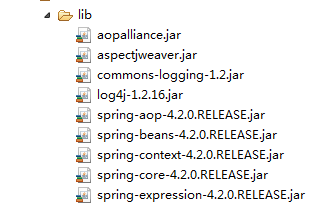
在entity包下新建一個實體類User
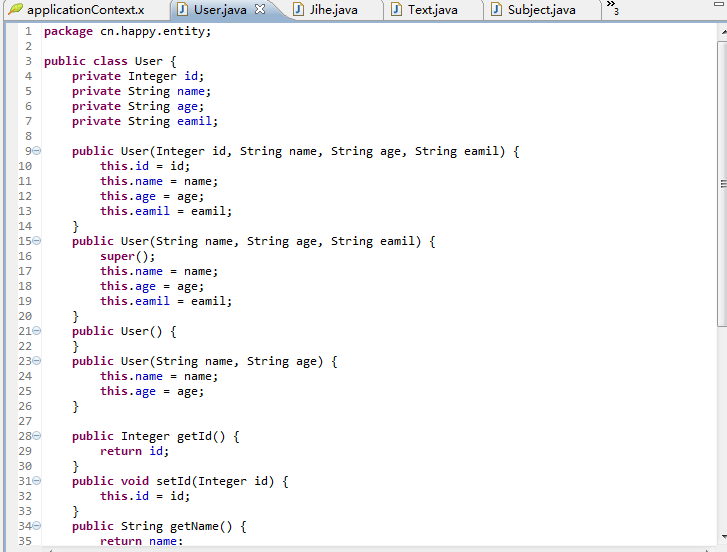
代碼:

![]()
1 package cn.happy.entity;
2
3 public class User {
4 private Integer id;
5 private String name;
6 private String age;
7 private String eamil;
8
9 public User(Integer id, String name, String age, String eamil) {
10 this.id = id;
11 this.name = name;
12 this.age = age;
13 this.eamil = eamil;
14 }
15 public User(String name, String age, String eamil) {
16 super();
17 this.name = name;
18 this.age = age;
19 this.eamil = eamil;
20 }
21 public User() {
22 }
23 public User(String name, String age) {
24 this.name = name;
25 this.age = age;
26 }
27
28 public Integer getId() {
29 return id;
30 }
31 public void setId(Integer id) {
32 this.id = id;
33 }
34 public String getName() {
35 return name;
36 }
37 public void setName(String name) {
38 this.name = name;
39 }
40 public String getAge() {
41 return age;
42 }
43 public void setAge(String age) {
44 this.age = age;
45 }
46 public String getEamil() {
47 return eamil;
48 }
49 public void setEamil(String eamil) {
50 this.eamil = eamil;
51 }
52 @Override
53 public String toString() {
54 return "User [id=" + id + ", name=" + name + ", age=" + age
55 + ", eamil=" + eamil + "]";
56 }
57
58 }
User
在applicationContext.xml裡面寫
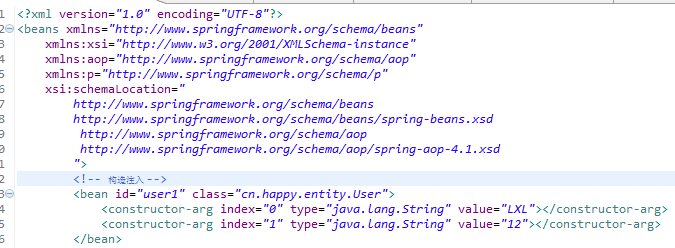
約束-頭:
別忘記帶這個不然會報錯的applicationContext.xml裡面!

![]()
1 <?xml version="1.0" encoding="UTF-8"?>
2 <beans xmlns="http://www.springframework.org/schema/beans"
3 xmlns:xsi="http://www.w3.org/2001/XMLSchema-instance"
4 xmlns:aop="http://www.springframework.org/schema/aop"
5 xmlns:p="http://www.springframework.org/schema/p"
6 xsi:schemaLocation="
7 http://www.springframework.org/schema/beans
8 http://www.springframework.org/schema/beans/spring-beans.xsd
9 http://www.springframework.org/schema/aop
10 http://www.springframework.org/schema/aop/spring-aop-4.1.xsd
11 ">
applicationContext.xml
代碼:

![]()
1 <bean id="user1" class="cn.happy.entity.User">
2 <constructor-arg index="0" type="java.lang.String" value="LXL"></constructor-arg>
3 <constructor-arg index="1" type="java.lang.String" value="12"></constructor-arg>
4 </bean>
applicationContext.xml
測試類:Text

代碼:

![]()
1 public class Text {
2 @Test
3 public void inner(){
4 gouinner();
5 }
6 //p命名空間注入
7 static void gouinner(){
8 ApplicationContext context=new ClassPathXmlApplicationContext("applicationContext.xml");
9 User user=(User)context.getBean("user1");
10 System.out.println(user);
11 }
text
結果:
2.P命名空間注入
這個實體類和上面的一樣就演示了
在applicationContext.xml裡面寫

代碼:

![]()
1 <!-- p命名空間注入 -->
2 <bean id="user2" class="cn.happy.entity.User" p:name="你的肉" p:age="1" p:eamil="
[email protected]"/>
3
applicationContext.xml
測試類Text:

代碼:

![]()
1 @Test
2 public void inner(){
3 Pinner();
4 }
5 //構造注入
6 static void Pinner(){
7 ApplicationContext context=new ClassPathXmlApplicationContext("applicationContext.xml");
8 User user=(User)context.getBean("user2");
9 System.out.println(user);
10 }
text
結果:

3.注入集合的屬性
List
實體類Jihe:
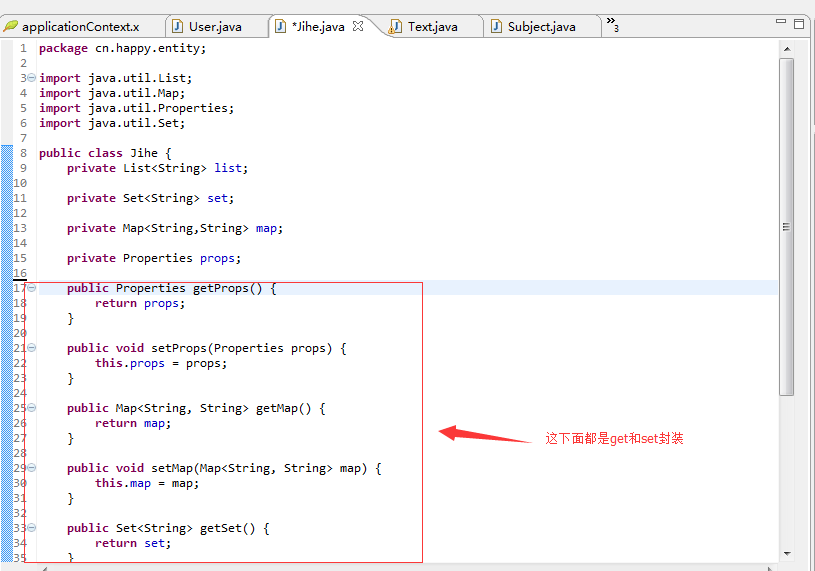
代碼:

![]()
1 package cn.happy.entity;
2
3 import java.util.List;
4 import java.util.Map;
5 import java.util.Properties;
6 import java.util.Set;
7
8 public class Jihe {
9 private List<String> list;
10
11 private Set<String> set;
12
13 private Map<String,String> map;
14
15 private Properties props;
16
17 public Properties getProps() {
18 return props;
19 }
20
21 public void setProps(Properties props) {
22 this.props = props;
23 }
24
25 public Map<String, String> getMap() {
26 return map;
27 }
28
29 public void setMap(Map<String, String> map) {
30 this.map = map;
31 }
32
33 public Set<String> getSet() {
34 return set;
35 }
36
37 public void setSet(Set<String> set) {
38 this.set = set;
39 }
40
41 public List<String> getList() {
42 return list;
43 }
44
45 public void setList(List<String> list) {
46 this.list = list;
47 }
48
49 }
Jihe
在applicationContext.xml裡面寫

代碼:

![]()
1 <!-- list -->
2 <bean id="list1" class="cn.happy.entity.Jihe">
3 <property name="list">
4 <list>
5 <value>你的肉</value>
6 <value>你的菜</value>
7 </list>
8 </property>
9 </bean>
applicationContext.xml
測試類Text:

代碼:

![]()
1 public class Text {
2 @Test
3 public void inner(){
4 listinner();
5 }
6 //list
7 static void listinner(){
8 ApplicationContext context=new ClassPathXmlApplicationContext("applicationContext.xml");
9 Jihe jihe=(Jihe)context.getBean("list1");
10 System.out.println(jihe.getList());
11 }
Text
結果:

Set:
實體類和List的實體類一樣
在applicationContext.xml裡面寫

代碼:

![]()
1
2 <!-- Set -->
3 <bean id="set1" class="cn.happy.entity.Jihe">
4 <property name="set">
5 <set>
6 <value>jd</value>
7 <value>tb</value>
8 </set>
9 </property>
10 </bean>
applicationContext.xml
測試類Text:

代碼:

![]()
1 @Test
2 public void inner(){
3 setinner();
4 }
5
6 //set
7 static void setinner(){
8 ApplicationContext context=new ClassPathXmlApplicationContext("applicationContext.xml");
9 Jihe jihe=(Jihe)context.getBean("set1");
10 System.out.println(jihe.getSet());
11 }
Text
結果:

Map
實體類和List的也一樣
在applicationContext.xml裡面寫

代碼:

![]()
1 <!-- map -->
2 <bean id="map1" class="cn.happy.entity.Jihe">
3 <property name="map">
4 <map>
5 <entry key="football" value="足球"></entry>
6 <entry key="basketball" value="籃球"></entry>
7 </map>
8 </property>
9 </bean>
applicationContext.xml
測試類Text:

代碼:

![]()
1 public class Text {
2 @Test
3 public void inner(){
4 mapinner();
5 }
6
7 //map
8 static void mapinner(){
9 ApplicationContext context=new ClassPathXmlApplicationContext("applicationContext.xml");
10 Jihe jihe=(Jihe)context.getBean("map1");
11 System.out.println(jihe.getMap());
12 }
Text
結果:

properties
實體類和List的也一樣
在applicationContext.xml裡面寫

代碼:

![]()
1 <!-- properties -->
2
3 <bean id="props1" class="cn.happy.entity.Jihe">
4 <property name="props">
5 <props>
6 <prop key="ndr">你的肉</prop>
7 <prop key="ndc">你的菜</prop>
8 </props>
9 </property>
10 </bean>
applicationContext.xml
測試類Text:

代碼:

![]()
1 public class Text {
2 @Test
3 public void inner(){
4 propinner();
5 }
6
7 //properties
8 static void propinner(){
9 ApplicationContext context=new ClassPathXmlApplicationContext("applicationContext.xml");
10 Jihe jihe=(Jihe)context.getBean("props1");
11 System.out.println(jihe.getProps());
12 }
Text
結果:

-------------------------------------------------------------------------------------------------------------------
接下來是!!!
靜態代理
代理模式 (靜態代理)
接口 :方法
---->RealClass:接口
---->ProxyClass:接口
private 接口類型 接口變量;
public void 同名方法(){
syso("增強處理");
接口變量.同名方法();
}
列表
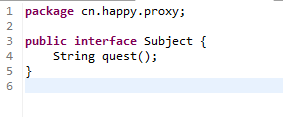
創建一個接口Subject:

代碼:

![]()
1 package cn.happy.proxy;
2
3 public interface Subject {
4 String quest();
5 }
Subject
在創建一個SubjectText類繼承Subject:
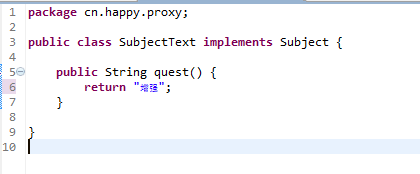
代碼:

![]()
1 package cn.happy.proxy;
2
3 public class SubjectText implements Subject {
4
5 public String quest() {
6 return "增強";
7 }
8
9 }
SubjectText
在創建一個代理類ProxySubject同樣繼承Subject:
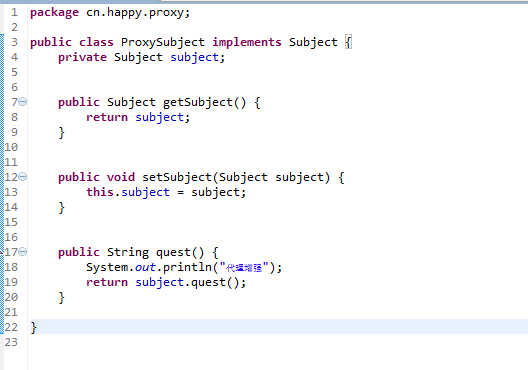
代碼:

![]()
1 package cn.happy.proxy;
2
3 public class ProxySubject implements Subject {
4 private Subject subject;
5
6
7 public Subject getSubject() {
8 return subject;
9 }
10
11
12 public void setSubject(Subject subject) {
13 this.subject = subject;
14 }
15
16
17 public String quest() {
18 System.out.println("代理增強");
19 return subject.quest();
20 }
21
22 }
ProxySubject
測試類Text:
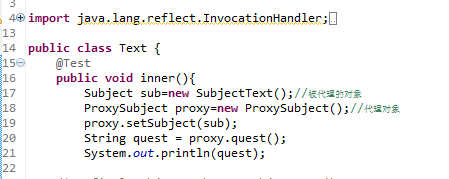
代碼:

![]()
1 package cn.happy.Text;
2
3
4 import java.lang.reflect.InvocationHandler;
5 import java.lang.reflect.Method;
6 import java.lang.reflect.Proxy;
7
8 import org.junit.Test;
9
10 import cn.happy.proxy.ProxySubject;
11 import cn.happy.proxy.Subject;
12 import cn.happy.proxy.SubjectText;
13
14 public class Text {
15 @Test
16 public void inner(){
17 Subject sub=new SubjectText();//被代理的對象
18 ProxySubject proxy=new ProxySubject();//代理對象
19 proxy.setSubject(sub);
20 String quest = proxy.quest();
21 System.out.println(quest);
22 }
23 }
24
Text
結果:

動態代理
proxy包裡的類和靜態代理的一樣只是測試類換了
測試類Text:
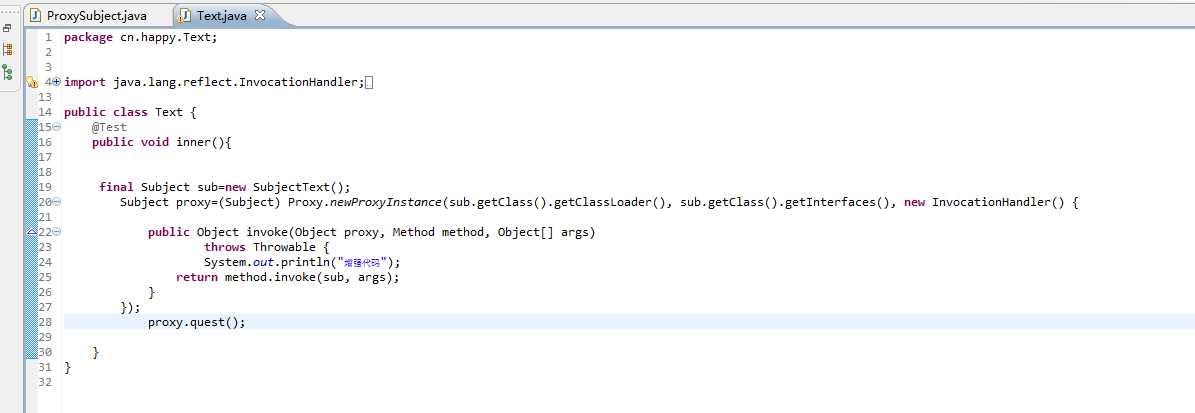
代碼:

![]()
1 package cn.happy.Text;
2
3
4 import java.lang.reflect.InvocationHandler;
5 import java.lang.reflect.Method;
6 import java.lang.reflect.Proxy;
7
8 import org.junit.Test;
9
10 import cn.happy.proxy.ProxySubject;
11 import cn.happy.proxy.Subject;
12 import cn.happy.proxy.SubjectText;
13
14 public class Text {
15 @Test
16 public void inner(){
17
18
19 final Subject sub=new SubjectText();
20 Subject proxy=(Subject) Proxy.newProxyInstance(sub.getClass().getClassLoader(), sub.getClass().getInterfaces(), new InvocationHandler() {
21
22 public Object invoke(Object proxy, Method method, Object[] args)
23 throws Throwable {
24 System.out.println("增強代碼");
25 return method.invoke(sub, args);
26 }
27 });
28 proxy.quest();
29
30 }
31 }
Text
結果:
















































